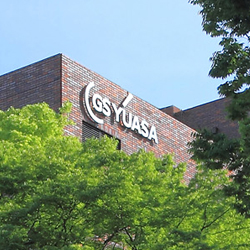Environmental Performance and Environmental Accounting
Environmental Performance Data
The Group’s Environmental Performance
Scope of application
- Scope
- The Group’s production bases (Domestic: 9 business sites; Overseas: 14 business sites)
- Scope of application regarding greenhouse gas emission
-
(1) The scope of application of Scopes 1 and 2 is the same as the above scope of application.
(2) Regarding the scope of application of Scope 3, the scope of calculation is clearly indicated for each category.
- Greenhouse gas emissions related to Scope 2
-
(1) Scope 2 emissions show the CO2 emissions calculated using the methods of the market-based method*.
(2) The CO2 conversion factor in the calculation of CO2 emissions associated with power usage uses the following published values. However, the conversion factor for electricity derived from renewable energy is set to zero.
Japan: Annual coefficient for each power company announced in accordance with the Act on Promotion of Global Warming Countermeasures
Outside of Japan: Annual coefficients announced in “Emissions Factors,” a publication of the International Energy Agency (IEA).
- Remarks
-
(1) Regarding greenhouse gases other than CO2 are excluded from calculation because their relationship to the Group’s business activities is negligible and due to extremely low emissions.
(2) Energy usage and CO2 emissions data are verified by a third party.
(3) All data was reviewed prior to disclosure.
A method of calculating Scope 2 emissions based on the contents of the contract for purchased electricity (a calculation method taking into account the amount of renewable energy procured)
CO2 emissions and water consumption by country (Fiscal 2024)
| Country | CO2 Emissions (t-CO2) |
Water Consumption (m³) |
|---|---|---|
| Japan | 151,135 | 2,417,899 |
| China | 1,944 | 9,371 |
| Taiwan | 15,273 | 85,298 |
| Vietnam | 7,187 | 163,149 |
| Malaysia | 970 | 12,501 |
| Indonesia | 55,709 | 288,759 |
| Thailand | 26,407 | 643,646 |
| Turkey | 34,445 | 678,235 |
| United Kingdom | 4,450 | 74,163 |
| United States | 7,635 | 41,076 |
| Australia | 10,669 | 40,936 |
| Hungary | 164 | 478 |
| Total | 315,986 | 4,455,512 |
CO2 emissions and water consumption by production sites for the Group (Fiscal 2024)
Please scroll sideways
| Country | Production site | CO2 Emissions (t-CO2) |
Water Consumption (m³) |
|---|---|---|---|
| Japan | GS Yuasa International Ltd. (Kyoto, Osadano, Gunma, Ritto and Kawagoe Plants) | 115,740 | 1,348,122 |
| GS Yuasa Energy Co., Ltd. | 26,522 | 841,557 | |
| GS Yuasa Ibaraki Co., Ltd. | 4,366 | 148,962 | |
| GS Yuasa Moldings Co., Ltd. | 2,801 | 39,677 | |
| GS Yuasa Azumino Co., Ltd. | 1,706 | 39,582 | |
| China | GS Battery (China) Co., Ltd. | 1,944 | 9,371 |
| Taiwan | GS Battery Taiwan Co., Ltd. | 15,273 | 85,298 |
| Vietnam | GS Battery Vietnam Co., Ltd. | 7,187 | 163,149 |
| Malaysia | GS Yuasa Battery Malaysia Sdn. Bhd. | 970 | 12,501 |
| Indonesia | PT. Trimitra Baterai Prakasa | 27,408 | 120,349 |
| PT. Yuasa Battery Indonesia | 28,301 | 168,410 | |
| Thailand | Siam GS Battery Co., Ltd. | 14,019 | 438,368 |
| Yuasa Battery (Thailand) Pub. Co., Ltd. | 7,300 | 155,557 | |
| GS Yuasa Siam Industry Ltd. | 5,087 | 49,721 | |
| Turkey | Inci GS Yuasa Aku Sanayi ve Ticaret Anonim Sirketi | 34,445 | 678,235 |
| United Kingdom | GS Yuasa Battery Manufacturing UK Limited | 4,450 | 74,163 |
| United States | Yuasa Battery, Inc. | 7,635 | 41,076 |
| Australia | Century Yuasa Batteries Pty. Limited | 10,669 | 40,936 |
| Hungary | GS Yuasa Hungary Ltd. | 164 | 478 |
Changes in Scope 1 and 2 emissions (Unit: t-CO2)
Please scroll sideways
| Items | FY 2020 | FY 2021 | FY 2022 | FY 2023 | FY 2024 |
|---|---|---|---|---|---|
| Scope 1 emissions | 63,867 | 67,085 | 64,841 | 57,838 | 58,153 |
| Scope 2 emissions | 284,985 | 285,785 | 249,204 | 270,299 | 257,833 |
| Total | 348,852 | 352,870 | 314,046 | 328,138 | 315,986 |
Our calculated Scope 3 emissions (Fiscal 2024)
Please scroll sideways
| No. | Category | CO2 Emissions (t-CO2) |
Scope of application |
|---|---|---|---|
| 1 | Purchased goods and services | 940,714 | GS Yuasa International Ltd. (items directly related to product manufacturing) |
| 2 | Capital goods | 160,843 | The Group’s production sites (domestic: 9 business sites; overseas: 14 business sites) |
| 3 | Fuel- and Energy-related activities not included in scope 1 or scope 2 | 60,434 | The Group’s production sites (domestic: 9 business sites; overseas: 14 business sites) |
| 4 | Upstream transportation and distribution | 7,979 | GS Yuasa International Ltd. (restricted to transportation of freight involving specified shippers*) |
| 5 | Waste generated in operations | 1,408 | Domestic production sites (9 business sites) |
| 6 | Business travel | 881 | Domestic production sites (9 business sites) |
| 7 | Employee commuting | 2,562 | Domestic production sites (9 business sites) |
| 12 | End-of-life treatment of sold products | 18,412 | GS Yuasa International Ltd. (disposal of our manufactured lead-acid batteries) |
| Total | 1,193,233 | ||
Shippers whose annual freight transportation volume exceeds 30 million ton-kilometers based on the Law Concerning the Rational Use of Energy
Changes in the water intake by the Group (Unit: m³)
Please scroll sideways
| Water source | FY 2020 | FY 2021 | FY 2022 | FY 2023 | FY 2024 |
|---|---|---|---|---|---|
| Water for industrial use (Third party water) |
2,412,307 | 2,259,858 | 2,129,786 | 2,101,644 | 2,111,376 |
| Underground water | 1,530,950 | 1,507,990 | 1,440,132 | 1,536,266 | 1,544,434 |
| Public water supply (Third party water) |
789,858 | 832,153 | 795,278 | 790,963 | 799,702 |
| Total | 4,733,116 | 4,600,001 | 4,365,196 | 4,428,873 | 4,455,512 |
There is no water intake from sources other than those listed in the table above.
Changes in the amount of wastewater (Unit: m³)
Please scroll sideways
| Discharge destination | FY 2020 | FY 2021 | FY 2022 | FY 2023 | FY 2024 |
|---|---|---|---|---|---|
| River | 1,964,975 | 1,843,706 | 1,741,475 | 1,793,963 | 1,898,020 |
| Sewage disposal | 1,935,404 | 1,880,884 | 1,702,239 | 1,710,687 | 1,691,371 |
| Total | 3,900,379 | 3,724,591 | 3,443,714 | 3,504,651 | 3,589,391 |
There are no discharges from business sites to the oceans or to water treatment facilities other than those at business sites.
Percentage of environmentally considered products in total sales of all products
Please scroll sideways
| FY 2020 | FY 2021 | FY 2022 | FY 2023 | FY 2024 |
|---|---|---|---|---|
| 34.8% | 36.5% | 36.4% | 38.7% | 36.7% |
Ratio of recycled lead used as lead raw materials in lead-acid batteries
Please scroll sideways
| FY 2020 | FY 2021 | FY 2022 | FY 2023 | FY 2024 |
|---|---|---|---|---|
| 54.6% | 63.3% | 56.5% | 65.7% | 72.4% |
Environmental Performance of Domestic Business Sites
Scope of application
- Scope
- Nine domestic sites ( GS Yuasa International Ltd. (Kyoto, Osadano, Gunma, Ritto and Kawagoe Plants), GS Yuasa Energy Co., Ltd., GS Yuasa Ibaraki Co., Ltd., GS Yuasa Moldings Co., Ltd. and GS Yuasa Azumino Co., Ltd.)
- Greenhouse gas emissions related to Scope 2
-
(1) Scope 2 emissions refer to CO2 emissions calculated based on the market-based method*.
(2) Scope 2 emissions are calculated using the annual coefficient for each power company announced in accordance with the Act on Promotion of Global Warming Countermeasures. However, the conversion factor for power derived from renewable energy is set as zero.
- Remarks
-
(1) Environmental performance related to transportation refers to actual values for GS Yuasa International Ltd.
(2) Energy usage and CO2 emissions data are certified by third parties.
(3) All data was reviewed prior to disclosure.
A method of calculating Scope 2 emissions based on the contents of the contract for purchased electricity.
Environmental performance data (Fiscal 2024)
Please scroll sideways
| Classification | Product life cycle | Items | Unit | Total | Content | Breakdown | Remarks |
|---|---|---|---|---|---|---|---|
| INPUT | Production | Amount of main materials consumption | t | 198,821 | Virgin materials | 101,702 | Lead, sulfuric acid, plastics, etc. |
| Recycled materials | 97,119 | ||||||
| Amount of water consumption | m³ | 2,417,899 | Water for industrial use | 1,082,991 | Third party water | ||
| Underground water | 1,032,999 | ||||||
| Public water supply | 301,909 | Third party water | |||||
| Amount of energy consumption (crude oil conversion) |
kL | 84,196 | Electricity | 70,104 | |||
| City gas | 10,913 | ||||||
| LPG | 3,016 | ||||||
| Kerosene, gasoline, diesel | 163 | ||||||
| Physical distribution | Amount of energy consumption (crude oil conversion) |
kL | 3,014 | Gasoline, diesel | 3,014 | Energy consumption based on volume of cargo transportation | |
| Waste | Volume of used products recovered | t | 4,944 | Industrial Batteries, Power Supplies | 4,944 | ||
| OUTPUT | Production | Amount of waste discharged | t | 15,640 | Waste plates, batteries, and lead paste | 4,873 | |
| Metal scraps | 489 | ||||||
| Lithium-ion batteries | 4,412 | ||||||
| Waste paper and garbage | 1,055 | ||||||
| Sludge | 1,134 | ||||||
| Waste acids, alkaline substances | 1,063 | ||||||
| Waste plastic | 1,088 | Emissions at GS Yuasa International Ltd.: 508t | |||||
| Wood scraps | 558 | ||||||
| Other | 968 | ||||||
| Amount of recycling | t | 15,079 | Waste plates, batteries, and lead paste | 4,873 | |||
| Metal scraps | 480 | ||||||
| Lithium-ion batteries | 4,412 | ||||||
| Waste paper and garbage | 970 | ||||||
| Sludge | 1,013 | ||||||
| Waste acids, alkaline substances | 970 | ||||||
| Waste plastic | 972 | ||||||
| Wood scraps | 489 | ||||||
| Other | 893 | ||||||
| Amount of final disposal | t | 561 | Waste plates, batteries, and lead paste | 0 | |||
| Metal scraps | 8 | ||||||
| Lithium-ion batteries | 0 | ||||||
| Waste paper and garbage | 85 | ||||||
| Sludge | 121 | ||||||
| Waste acids, alkaline substances | 87 | ||||||
| Waste plastic | 117 | ||||||
| Wood scraps | 69 | ||||||
| Other | 75 | ||||||
| Amount of wastewater | m³ | 2,024,785 | Public water body | 1,198,111 | River | ||
| Sewage disposal | 826,675 | ||||||
| Amount of CO2 emissions | t-CO2 | 151,135 | Electricity | 122,008 | Scope 2 emissions | ||
| City gas | 21,709 | Scope 1 emissions | |||||
| LPG | 6,984 | ||||||
| Kerosene, gasoline, diesel | 434 | ||||||
| Physical distribution | Amount of CO2 emissions | t-CO2 | 7,979 | 7,979 | Scope 3 emissions (category 4) | ||
| Waste | Volume of used products recycling | t | 4,093 | 4,093 | |||
| Final disposal volume (used products) | t | 851 | 851 |
Status of violations of permits, standards, and regulations related to water quality and quantity (Fiscal 2024)
| Items | Number of violations of laws and regulations for which have been imposed penalties |
Number of administrative measures |
|---|---|---|
| Water intake | 0 | 0 |
| Wastewater | 0 | 0 |
Data on changes in environmental performance
Please scroll sideways
| Category | Items | Unit | FY 2020 | FY 2021 | FY 2022 | FY 2023 | FY 2024 |
|---|---|---|---|---|---|---|---|
| INPUT | Amount of main materials consumption | t | 186,225 | 188,020 | 186,298 | 193,473 | 198,821 |
| Amount of water consumption | m³ | 2,455,407 | 2,348,351 | 2,256,768 | 2,380,824 | 2,417,899 | |
| Amount of energy consumption in production (crude oil conversion) |
kL | 96,772 | 98,869 | 99,872 | 100,758 | 84,196 | |
| Amount of energy consumption in physical distribution (crude oil conversion) |
kL | 3,409 | 3,598 | 3,302 | 3,040 | 3,014 | |
| Volume of used products recovered | t | 5,006 | 4,773 | 4,573 | 4,515 | 4,944 | |
| OUTPUT | Amount of recycling (waste) | t | 11,126 | 12,083 | 12,625 | 13,634 | 15,079 |
| Amount of final disposal (waste) | t | 598 | 504 | 633 | 625 | 561 | |
| Amount of wastewater | m³ | 2,171,530 | 2,020,468 | 1,960,932 | 2,034,434 | 2,024,785 | |
| Amount of CO2 emissions in production | t-CO2 | 146,888 | 134,505 | 109,634 | 133,325 | 151,135 | |
| Amount of CO2 emissions in physical distribution | t-CO2 | 8,953 | 9,484 | 8,702 | 8,039 | 7,979 | |
| Volume of used products recycling (used products) |
t | 4,156 | 3,952 | 3,782 | 3,733 | 4,093 | |
| Final disposal volume (used products) |
t | 850 | 822 | 791 | 782 | 851 |
Changes in consumption of major raw materials
Please scroll sideways
| Items | Unit | FY 2020 | FY 2021 | FY 2022 | FY 2023 | FY 2024 |
|---|---|---|---|---|---|---|
| Lead compounds | t | 139,299 | 139,669 | 134,251 | 139,087 | 143,162 |
| Sulfate | t | 30,189 | 30,899 | 29,286 | 29,193 | 30,698 |
| Plastic | t | 13,800 | 13,351 | 13,493 | 14,591 | 13,193 |
Status of release and transfer of substances subject to the PRTR Law (Unit: kg)
Please scroll sideways
| Substances subject to the PRTR Law |
Sites | Released into the air |
Released into public waterways |
Transferred to sewage system |
Transferred outside the site |
Total |
|---|---|---|---|---|---|---|
| Lead compounds* | Kyoto | 150.0 | 0.0 | 5.1 | 13,000.0 | 13,155.1 |
| Osadano | 46.0 | 0.0 | 6.0 | 1,100.0 | 1,152.0 | |
| Gunma | 29.0 | 3.8 | 0.0 | 200.0 | 232.8 | |
| GS Yuasa Energy | 9.0 | 2.7 | 0.0 | 2,800.0 | 2,811.7 | |
| GS Yuasa Ibaraki | 8.0 | 6.1 | 0.0 | 30.0 | 44.1 | |
| GS Yuasa Azumino | 6.9 | 0.0 | 0.0 | 11.0 | 17.9 | |
| Arsenic and its inorganic compounds* | Kyoto | 2.4 | 0.0 | 0.4 | 3.3 | 6.1 |
| Gunma | 0.0 | 0.5 | 0.0 | 0.0 | 0.5 | |
| GS Yuasa Energy | 0.0 | 0.0 | 0.0 | 0.6 | 0.6 | |
| Antimony and its compounds | Kyoto | 0.0 | 5.1 | 0.4 | 1.2 | 6.7 |
| Osadano | 0.0 | 0.0 | 1.8 | 0.0 | 1.8 | |
| Gunma | 0.0 | 1.9 | 0.0 | 0.0 | 1.9 | |
| GS Yuasa Energy | 0.0 | 0.0 | 0.0 | 0.5 | 0.5 | |
| Manganese and its compounds | Kyoto | 0.0 | 0.0 | 0.0 | 1,900.0 | 1,900.0 |
| Osadano | 8.8 | 0.0 | 0.0 | 0.2 | 9.0 | |
| Ritto | 0.0 | 0.0 | 0.0 | 1,900.0 | 1,900.0 | |
| Nickel compounds* | Kyoto | 0.0 | 0.0 | 0.0 | 4,500.0 | 4,500.0 |
| Osadano | 2.9 | 0.0 | 0.0 | 0.3 | 3.2 | |
| Ritto | 0.0 | 0.0 | 0.0 | 2,800.0 | 2,800.0 | |
| Cobalt and its compounds | Kyoto | 0.0 | 0.0 | 0.0 | 1,600.4 | 1,600.4 |
| Osadano | 0.2 | 0.0 | 0.0 | 0.2 | 0.4 | |
| Ritto | 0.0 | 0.0 | 0.0 | 1,100.0 | 1,100.0 | |
| Dichloromethane | GS Yuasa Ibaraki | 1,900.0 | 0.0 | 0.0 | 50.0 | 1,950.0 |
| N,N-dimethylformamide | GS Yuasa Molding | 2.0 | 0.0 | 400.0 | 1,500.0 | 1,902.0 |
| boron compounds | Osadano | 2.5 | 0.0 | 0.0 | 1,000.0 | 1,002.5 |
| N-Methyl-2-pyrrolidone | Kyoto | 7,300.0 | 0.0 | 0.0 | 2,748.0 | 10,048.0 |
| Osadano | 0.0 | 0.0 | 0.0 | 0.0 | 0.0 | |
| Ritto | 0.0 | 0.0 | 0.0 | 0.0 | 0.0 | |
| Diethanolamine | Osadano | 0.0 | 0.0 | 0.0 | 0.0 | 0.0 |
Production of Specific Class I Designated Chemical Substances
Environmental Accounting
Scope of calculations for environmental accounting
- Structures
- Nine domestic sites (GS Yuasa International Ltd. (Kyoto, Osadano, Gunma, Ritto and Kawagoe Plants), GS Yuasa Energy Co., Ltd., GS Yuasa Ibaraki Co., Ltd., GS Yuasa Moldings Co., Ltd. and GS Yuasa Azumino Co., Ltd.). Note, however, that environment-related equipment costs within business area costs do not include onsite affiliated companies.
- Period covered
- April 1, 2024 - March 31, 2025
- Reference
- Environmental Accounting Guidelines 2005 Edition (issued by the Ministry of the Environment)
Environmental conservation costs (categorized by business activity)
Please scroll sideways
| Category | Key initiatives |
Total (Thousands of yen) |
|
|---|---|---|---|
| Business area costs (total) | 2,044,637 | ||
| Breakdown | Pollution prevention costs | Efforts to prevent air pollution | 483,441 |
| Efforts to prevent water pollution | 1,026,783 | ||
| Global environmental conservation costs |
Efforts to reduce greenhouse gas emissions |
196,904 | |
| Resource recycling costs | Efforts to ensure suitable disposal of waste |
337,510 | |
| Upstream and downstream costs*1 |
Additional efforts to reduce environmental burden |
18 | |
| Management activity costs*2 | Employee education and ISO 14001 maintenance and management |
4,480 | |
| Research and development costs |
Research and development efforts in consideration of the environment |
8,948,000 | |
| Social activity costs | Environmental volunteer efforts | 5,130 | |
| Environmental remediation costs |
Efforts related to soil pollution measures |
4,890 | |
| Total | 11,007,154 | ||
Economic effect of environmental conservation initiatives
Please scroll sideways
| Category | Key item | Monetary amount (Thousands of yen) |
|---|---|---|
| Economic effects of more efficient water use |
Water use and wastewater cost reduction*3 | 2,894 |
| Energy conservation effects | Cost reductions for electricity, heavy oil and gas (city gas, LNG, LPG)*3 |
-325,689 |
| Waste reduction effects | Cost reduction for industrial waste treatment*3 | -19,816 |
| Resource recycling effects | Profit from recycling and reusing waste | 621,389 |
Effect of environmental conservation
| Category | Key items | Material amount | Unit |
|---|---|---|---|
| Effects related to resources used in business activities | Amount of recycled water used | 1,127,418 | m³ |
| Amount of reduction in water use*3 | -37,076 | m³ | |
| Amount of energy saved (crude oil conversion)*3 | 16,562 | kL | |
| Effects related to environmental burden and waste from business activities | Amount of CO2 reduced*3 | -17,810 | t-CO2 |
| Amount of waste reduced (final disposal volume) *3 | 64 | t | |
| Amount of wastewater reduced*3 | 9,649 | m³ | |
| Amount of waste recycled | 15,079 | t | |
| Recycling rate*4 | 96 | % | |
| [Water quality] Amount of lead discharged | 24 | kg | |
| [Air] Amount of lead emitted | 249 | kg |
1Upstream and downstream costs are the total of consulting expenses and expenses for contracts to create new products based on the Law for Promotion of Sorted Collection and Recycling of Containers and Packaging.
2In addition to employee education, and costs related to ISO 14001 maintenance and management, the management activity cost includes expenses related to information disclosure.
3The tables show amounts reduced compared with the previous fiscal year (negative amounts represent increases).
4Recycling rate (%) = (amount recycled / amount of waste) x 100
The files are in Adobe Acrobat Format. To view them you will need to download the Acrobat Reader.
Adobe Reader Download




